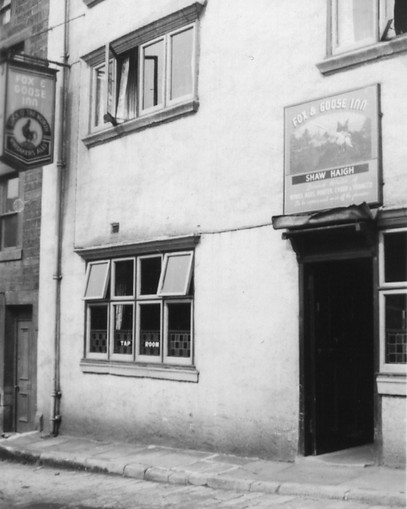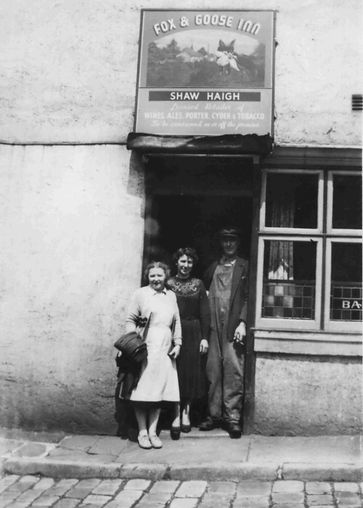
The Fox & Goose, Hebden Bridge
The first community-owned pub in West Yorkshire
CAMRA Good Beer Guide, Halifax and Calderdale Pub of the Year 2022 & 2019

The History of the Fox & Goose
The Fox & Goose is thought to stand on the site of an illegal medieval alehouse, this sort of den being known as a tiddlywink (in the south west these were kidly-winks). It would have been a simple single storey building, possibly with an undercroft for animals. Neither the A646 nor Heptonstall Road existed then. and the alehouse is thought to have stood by an intersection of ancient routes. A continuation of Old Gate from the old bridge in the centre of Hebden Bridge ran across the hillside just behind the site of the current pub to cross Colden Clough before ascending Rawtenstall Bank, while a smaller route zigzagged up through the woods to Heptonstall, a continuation of Whins Lane that runs down from the Social & Bowling Club. The small settlement at this junction was variously known as Wyndybank, Wyndhill or Whinsbank, wynd being a Celtic word for a narrow winding path. There is a reference to brewing here in 1313 and Margery de Wyndhill was regularly fined for 'brewing and selling ale contrary to the assize' at a site on or very close to the Fox & Goose between 1331 and 1348. At her death in 1351, she had profited enough from the trade to own 1½ acres of land in Sowerby parish, though we don't know if her daughter Isabella de Wyndybank continues the trade.

There is a reference to the Winn Inn, an alehouse run by John Lome on the site of the Fox & Goose, in the 16th century. However, the three-storey buildings at the foot of what is now Heptonstall Road, including parts of the Fox &Goose, are thought to have been built around 1660 by John Sutcliffe, an MP and member of the Sutcliffe family, who owned most of Rawtenstall parish from Hebden Bridge to Blackshaw Head and Eastwood. Litt House was a large complex of buildings made up of private accommodation and workshops for weaving and dyeing cloth (litt being a traditional word for dye), and included a gatehouse across the old track that led down to the river. The Fox & Goose itself had a brewhouse and blacksmiths shop on the ground floor and an ale house (now officially sanctioned) on the first floor. There is lots of evidence in the masonry of the pub and its neighbours of these older structures beneath the later additions.

In the 1720s Litt House was remodelled by John's grandson, Solomon John, including the addition of several further workshops and a row of cottages known as Solomon's Temple (now Sunnybank). When the new Halifax-Burnley Turnpike was opened along the route of the modern A646 in the 1770s, the southern wing and gatehouse of Litt House were pulled down, and the works moved down towards the river. The rest of the property was sold to blacksmith John Foster for £39, with brewing and smithing continued on the site, before it was sold to victualler William Patchett in the 1780s. Heptonstall Road (then known as New Road) was only built in 1782, creating the junction on which the Fox & Goose now stands.
We're not entirely sure when the Fox & Goose first acquired its name, but the first reference we have is from 1857. Throughout much of the 19th century it was a beer house under the ownership of the Patchett family, who also owned the Grove Inn and Brewery at Brearley. Several tenant landlords ran the pub during this time, including the Taylor family, two of whose children died tragically nearby – 6-year old Frank Taylor drowned in Colden Beck in 1880 (more details) and Ellen gassed herself in a neighbouring house in 1899 (more details). Their father Paul Taylor moved to the White Lion in Heptonstall in 1900, with the Fox & Goose (now under the ownership of the Grove Brewery) run by his son-in-law John Butterworth. The pub was significantly remodelled in 1905, with the beer house moved from the first floor to the ground floor and a flat established above. The modern frontage that we know today was added, along with a flat-roofed extension for the toilets, the gents being where the beer store now is and the ladies in what is now the gents. In 1925, all of the Grove Brewery's pubs were sold to the Halifax brewer, Richard Whitaker & Sons, and the pub was subsequently tenanted by several licensees for Whitakers, including Kelita Jagger, Lewis Bannister, Edward Lord, Shaw & Nellie Haigh (whose name features on the wooden sign over the door in the pictures below from 1954) and Madison Kelly.


Whitakers Brewery closed down in 1969, with the pub being transferred to Whitbread until its sale to Kevin McCarthy, a former policeman from Middleton, in 1980. With the pub now a free house, he transformed the interior by installing a new bar and the mock Tudor decor and Artex paintwork we are so fond of today. The Fox & Goose was sold to a former tenant Marlene Mills in 1985, before passing in 1989 to Robin Starbuck, under whose stewardship it gained a reputation for serving a range of high quality cask real ale. Simon Trapp and Julia Warren continued this work from 2003 and, along with Rachel Lockwood and Jayne Allen, undertook detailed research into the pub's history that informs most of this writing. The result of their work is available to download via the link below:
The Fox and Goose Inn: A Pathway Through History PDF
If anyone who has any further historical information or photographs, please send them through to info@foxandgoose.org